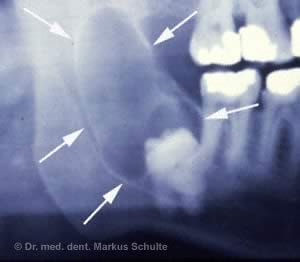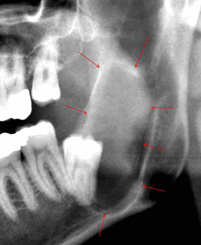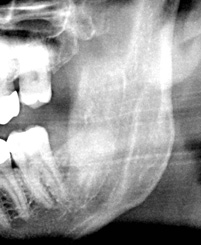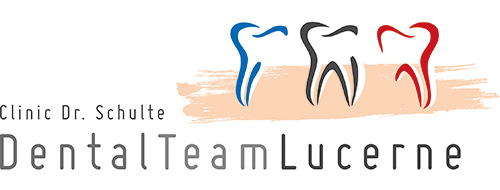Oral cysts - what are jaw cysts and why do they form?

Cysts are hollow spaces in the bone that are filled with fluid or pulpy material and lined with a thin membrane. Causes of cyst formation can include chronic inflammation at the root of a tooth, known as a "radicular cyst," or remnants of the dental follicle or periodontal ligament, known as a "follicular cyst" or "periodontal cyst," respectively. Some people are more prone to developing cysts due to inherited traits.
Why do cysts need to be removed?
Cysts behave like benign tumors, meaning they grow constantly and can cause damage by expanding the bone and displacing nearby structures such as tooth roots, sinus and nasal cavity walls. If bacteria enter the cyst, it can become infected and form an abscess. Large cysts can weaken the bone and increase the risk of a jaw fracture. In rare cases, cysts can become malignant.
How is cyst removal performed?
Usually under local anesthesia, sometimes with nitrous oxide sedation, conscious sedation or, in exceptional cases, general anesthesia. During cystectomy, the cyst is completely removed from the bone after it has been exposed. The responsible tooth may be extracted or preserved through root canal therapy. For larger cysts, the cavity can be filled with bone or bone substitute material. The wound is then tightly closed with sutures. Complete bone regeneration typically occurs in a few months.
Very large cysts may not be able to be removed entirely. In these cases, cystostomy is performed: the cyst cavity is only opened from the outside (fenestrated) to release pressure. If the cyst window is kept open consistently over several months, the cavity gradually fills with bone.
Jaw cyst - a case from our practice
In this 45-year-old patient, a large cyst had developed in the left lower jaw originating from an impacted wisdom tooth. Due to the risk of jaw fracture and injury to the inferior alveolar nerve, which supplies sensation to the lower lip, complete cyst removal (cystectomy) was not an option. Therefore, the cyst was fenestrated (cystostomy) and the window was kept open with a cyst plug (obturator). After six months, the bone had regenerated sufficiently to allow removal of the wisdom tooth and the remaining cystic tissue. After 12 months, the former bone defect had completely filled with bone. The X-ray image shows perfect regeneration of the jawbone.



